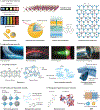Multifunctional materials for implantable and wearable photonic healthcare devices
- PMID: 32728478
- PMCID: PMC7388681
- DOI: 10.1038/s41578-019-0167-3
Multifunctional materials for implantable and wearable photonic healthcare devices
Abstract
Numerous light-based diagnostic and therapeutic devices are routinely used in the clinic. These devices have a familiar look as items plugged in the wall or placed at patients' bedsides, but recently, many new ideas have been proposed for the realization of implantable or wearable functional devices. Many advances are being fuelled by the development of multifunctional materials for photonic healthcare devices. However, the finite depth of light penetration in the body is still a serious constraint for their clinical applications. In this Review, we discuss the basic concepts and some examples of state-of-the-art implantable and wearable photonic healthcare devices for diagnostic and therapeutic applications. First, we describe emerging multifunctional materials critical to the advent of next-generation implantable and wearable photonic healthcare devices and discuss the path for their clinical translation. Then, we examine implantable photonic healthcare devices in terms of their properties and diagnostic and therapeutic functions. We next describe exemplary cases of noninvasive, wearable photonic healthcare devices across different anatomical applications. Finally, we discuss the future research directions for the field, in particular regarding mobile healthcare and personalized medicine.
Conflict of interest statement
Competing interests The authors declare no competing interests.
Figures





References
-
- Van Soest G, Regar E & van der Steen AFW Photonics in cardiovascular medicine. Nat. Photonics 9, 626–629 (2015).
-
- Kim H et al. Multifunctional photonic nanomaterials for diagnostic, therapeutic, and theranostic applications. Adv. Mater 30, 1701460 (2018). - PubMed
-
This review paper describes the fundamental science, synthetic concepts, characteristics and biomedical applications of multifunctional photonic nanomaterials that can interact through light with biological systems.
-
- Helmchen F & Denk W Deep tissue two-photon microscopy. Nat. Methods 2, 932–940 (2005). - PubMed
-
- Tuchin VV Polarized light interaction with tissues. J. Biomed. Opt 21, 071114 (2016). - PubMed
Grants and funding
LinkOut - more resources
Full Text Sources
Other Literature Sources
